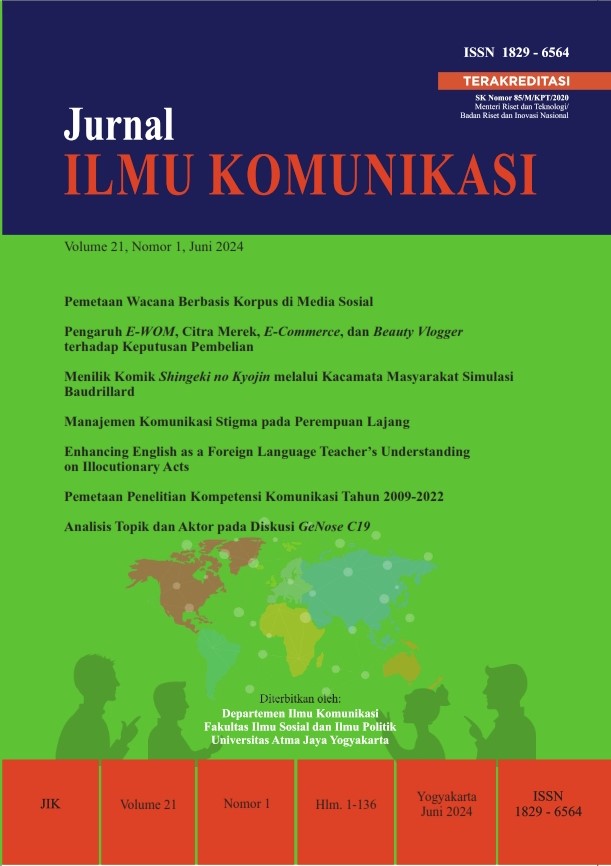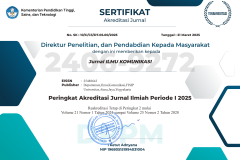Menilik Komik Shingeki no Kyojin melalui Kacamata Masyarakat Simulasi Baudrillard
DOI:
https://doi.org/10.24002/jik.v21i1.6361Keywords:
capital society, hyperreality, manga, media, simulacraAbstract
Hajime Isayama’s Shingeki no Kyojin tells the disruption on Paradis Island’s stability as Titans ambush. This article found the Paradis Island is the perfect representation of Jean Baudrillard’s simulacra society which is trapped in a chaos of reality and simulations in hyperreality. Through the Barthes’s semiotic model, this article finds that Paradis Island’s a perfect hyperreal site that traps its inhabitants in simulacra and blurs anything beyond the wall. Repression and propaganda complicate people’s understanding on politics. In reflection to current state, media are trapping society inside walls of their preferences to blur the reality behind or beyond the wall.References
Alyatalatthaf, M. D. M. (2019). Seppuku dan nilai-nilai bushido dalam film Letters from Iwo Jima. Jurnal Ilmu Komunikasi, 16(2), 143–160.
Anindita, R., M., & Yuwono, A. I. (2023). Female masculinity representation in still sick yuri manga: Indonesian perspective. International Journal of Indonesian Popular Culture and Communication, 4(1), 1–21.
Azuma, H. (2009). Otaku: Japan’s database animals. Minneapolis, USA: Universtiy of Minnesota Press.
Bartlett, J. (2021). Matinya demokrasi dan kuasa teknologi: Bagaimana internet menghancurkan demokrasi. Manado, Indonesia: Globalindo Publisher.
Baudrillard, J. (1983). Simulations. New York, USA: Semiotext(e) Inc.
----------------. (1994). Simulacra and simulation. Michigan, USA: University of Michigan Press.
----------------. (2006). The precession of simulacra. In M. G. Durham & D. M. Kellner (Eds.), Media and cultural studies (Revised Ed, pp. 453–481). Malden, USA: Blackwell Publishing.
Bolton, C. (2018). Interpeting Anime. Minneapolis, USA: University of Minnesota Press.
Cinelli, M., Morales, G. D. F, Galeazzi, A., Quattrociocchi, W., & Starnini, M. (2021). The echo chamber effect on social media. Proceedings of the National Academy of Sciences of the United States of America, 118(9).
Fuller, S. (2023). Shaken not stirred: The name of the game in the post-truth condition. Critical Review, 35(1-2), 22-39.
Hardiman, F. B. (2021). Aku klik, maka aku ada. Yogyakarta, Indonesia: Kanisius.
Isayama, H. (2010a). Attack on Titan Vol. 1. Tokyo, Jepang: Kodansha.
-------------. (2014). Attack on Titan Vol. 15. Tokyo, Jepang: Kodansha.
-------------. (2016). Attack on Titan Vol. 21. Tokyo, Jepang: Kodansha.
-------------. (2018). Attack on Titan Vol. 25. Tokyo, Jepang: Kodansha.
-------------. (2021). Attack on Titan Vol. 34. Tokyo, Jepang: Kodansha.
Jackson, H. S. (2023). The carceral appropriation of communications technology through the imaginal. Philosophy and Social Criticism, 1–15.
King, R. (2023). Re-writing history, re-inscribing the city: Thailand and delusions of democracy. Environment and Planning C: Politics and Space, 41(7), 1391-1406.
Krevel, M. (2019). Taking the i out of being taking the i out of being: Zen buddhism and postmodern (dis) contents in Ruth Ozeki’s a tale for the time being. Journal of the Spanish Association of Anglo-American Studies, 41(1), 89–108.
Kusumanto, D. (2021). Inilai komik-komik best seller terbitan elex media selama 2021. Kaori Nusantara. <https://www.kaorinusantara.or.id/newsline/174616/inilah-komik-komik-best-seller-terbitan-elex-media-selama-2021>
Lakshyayog. (2023). Production of fit city: Physical (in)activity, body and everyday space in Delhi. Social Change, 53(2), 226–239.
Lata, & Bhatt, P. (2023). Social media as a cause of emotional distress and insecurity in “nosedive” from black mirror. Quarterly Review of Film and Video.
Launa. (2017). Representasi ideologi aparatur negara dalam media (Studi konstruksi realitas wartawan humas pemda DKI mengenai lingkungan pemda DKI dalam pemberitaan website Beritajakarta.com). Jurnal Studi Komunikasi dan Media, 21(2), 203–223.
Lilja, M., & Wasshede, C. (2016). The performative force of cultural products: Subject positions and desires emerging from engagement with the manga boys’ love and yaoi. Culture Unbound, 8(3), 284–305.
Listianti, F. (2022). Sign consumption and fetishism behind the hyperreality of plant collection trends during a pandemic. Humaniora, 13(2), 177–188.
Loo, E. (2019). Attack on titan manga celebrates 100 million copies with giant mural at NYC madison square garden. Anime News Network. <https://www.animenewsnetwork.com/interest/2019-12-25/attack-on-titan-manga-celebrates-100-million-copies-with-giant-mural-at-nyc-madison-square-garden/.154747>
Luthfi, A. H. (2020). Analisis semiotika kritik sosial dalam balutan humor pada komik faktap. Jurnal Ilmu Komunikasi, 17(1), 19–40.
Maghfiroh, L., & Hapsari, N. (2014). A celebrification of celebgram on instagram: A case study of @shireeenz. Allusion, 4(1), 57–62.
Manurung, E. M., & Alvin, I. (2021). A new decade for social changes fashion and desire: The society of spectacle in post reality. Technium Social Sciences Journal, 20(1), 877–887.
Marwick, A. (2017). Microcelebrity, self-branding, and the Internet. The Blackwell Encyclopedia of Sociology, 1–3.
Nurhayati-Wolff, H. (2021). Internet usage in Indonesia–statistics & facts. Statista.com. <https://www.statista.com/topics/2431/internet-usage-in-indonesia/#dossierKeyfigures>
Okuyama, Y. (2015). Japanese mythology in film: Japanese mythology in film a semiotic approach to reading japanese film and anime. Maryland, USA: Lexington Books.
Patton, M. Q. (2015). Qualitative research & evaluation methods. (Fourth Edition). California, USA: SAGE Publication.
Peters, M. (2021). Here are the top-selling manga in 2021. Comicbook. <https://comicbook.com/anime/news/manga-anime-sales-2021-oricon/>
Richardson, P. (2019). Sovereignty, the hyperreal, and “taking back control”. Annals of the Association American Geographers, 109(6), 1999–2015.
Santos, E. A. (2020). The society of the spectacle and the society of control. International Journal of Arts and Social Science, 3(1), 1–12.
Setiawan, J., & Sudrajat, A. (2018). Pemikiran postmodernisme dan pandangannya terhadap ilmu pengetahuan. Jurnal Filsafat, 28(1), 25-46.
Shullenberger, G. (2021). Put not thy trust in nate silver. The New Atlantis, Winter 2021(63), 43–51.
Siregar, J. P. (2019). The ideological meanings of heritage: The conflicting symbols in Yogyakarta, Indonesia. Dimensi (Journal of Architecture and Built Environment), 45(2), 121-131.
Stratton, J. (2020). Death and the spectacle in television and social media. Television and New Media, 21(1), 3–24.
Sunstein, C. R. (2018). #Republic: Divided democracy in the age of social media (Updated Ed). Princeton, USA: Princeton University Press.
Syahrial, G. B. (2017). Fenomena hiperrealitas pada cosplayer love live (Studi kasus tim Allerish). Japanology, 6(1), 16-27.
Taufiqurrachman. (2020). Representation of third-world tourism place in instagram. Open Journal of Social Sciences, 8(4), 336–354.
Widyaningrum, A. Y., & Nugraheni, Y. (2021). Hiperrealitas makna kesenangan dalam iklan bertema gaya hidup di media sosial. Jurnal Kawistara, 11(2), 174-185.
Wieczorek, M. (2019). Anthropological debates on place-making. Urban Anthropology and Studies of Cultural Systems and World Economic Development, 48(1-2), 1–12.
Wolny, R. W. (2017). Hyperreality and simulacrum: Jean Baudrillard and European postmodernism. European Journal of Interdisciplinary Studies, 8(1), 75-79.
Wong, K. Y. (2000). Wong kin yuen on the edge of spaces: Blade runner, ghost in the shell, and Hong Kong’s Cityscape. Science Fiction Studies, 27(1), 1–21.
Downloads
Published
How to Cite
Issue
Section
License

This work is licensed under a Creative Commons Attribution 4.0 International License.
Jurnal ILMU KOMUNIKASI is an academic journal. As such, it is dedicated to the open exchange of information. For this reason, JIK is freely available to individuals and institutions. Authors who publish in Jurnal ILMU KOMUNIKASI will release their articles under the Creative Commons Attribution (BY) License. This license allows anyone to copy and redistribute the article in any medium or format as well as remix, transform, and build upon the material for any purpose, even commercially as long as they credit the authors for the original creation. For details of the rights authors grants users of their work, see the "human-readable summary" of the license, with a link to the full license. (Note that "you" refers to a user, not an author, in the summary)
 This work is licensed under a Creative Commons Attribution 4.0 International License.
This work is licensed under a Creative Commons Attribution 4.0 International License.














